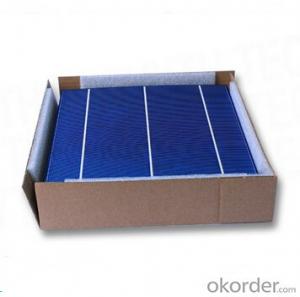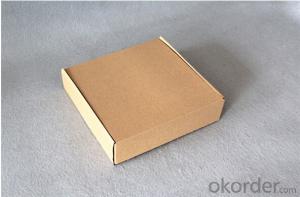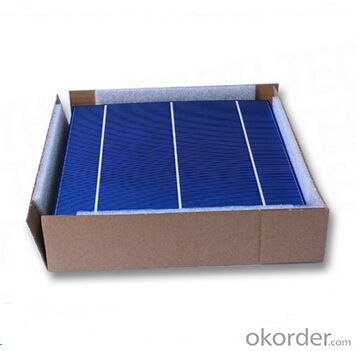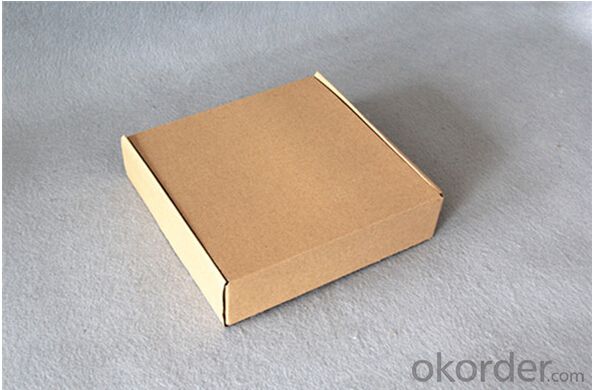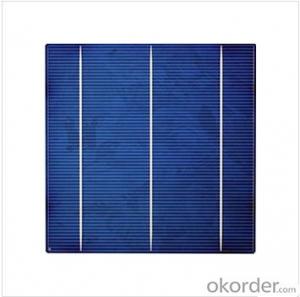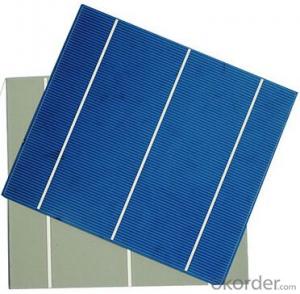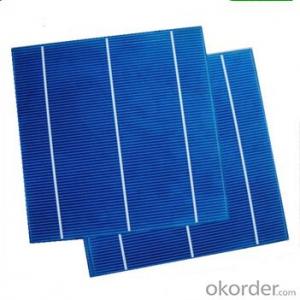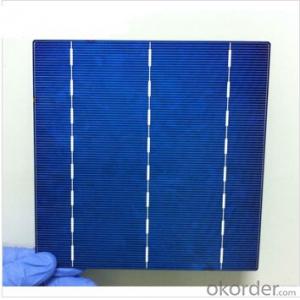Agbis2 Polycrystalline Solar Cells Series- 16.0-17.2
- Loading Port:
- Shanghai
- Payment Terms:
- TT OR LC
- Min Order Qty:
- 3000 pc
- Supply Capability:
- 300000 pc/month
OKorder Service Pledge
OKorder Financial Service
You Might Also Like
Solar Cells:
Solar cells is made by solar wafer, it has three categories of solar cell right now, monocrystalline polycrystalline and thin film,These cells are entirely based around the concept PN junction, which is the critical part of solar module, it is the part that can convert the light energy into electricity, the thickness is from 180um to 200um, with even busbars to conduct electricity, textured cell can decrease diffuse reflection; they are often electrically connected and encapsulated as a module. Photovoltaic modules often have a sheet of glass on the front (sun up) side, allowing light to pass while protecting semiconductor wafers from abrasion and impact due to wind-driven debris, rain, hail, etc. Solar cells are also usually connected in series in modules, creating an additive voltage. Connecting cells in parallel will yield a higher current;With high quality and stable quality. Our Cells can greatly improve the performance of Solar Modules.
Features:
1. High conversion efficiencies resulting in superior power output performance.
2. Proven long term mechanical stability of silicon
3. Make of highly purified poly silicon
4. Three bus bars for reduced series resistance and improved module and cell efficiency
5. Blue anti-reflecting coating ensures improved light absorption and increased efficiency
6. Acid texturization offers a uniform appearance and virtually invisible crystal structure
7. Excellent low light behavior for improved energy yield
Solar Cells Advantage:
1. Tire-1 Solar Cells’ Manufacturer Quality Guarantee. With a complete and sophisticated quality government system, our Quality Management have arrived world’s leading place. Customer can receive Tire-1 Cells Maker’s Quality Standard Products.
2. Trusted Warranty. We can supply trusted after-sales service to our customer. If our cells are found not in conformity to the specification of manufacturer, or should the inspected quantity found in shortage, or should the packing found damaged, the buyer has the right to claim to the seller. The claim, if any, should be presented to seller within 30 days after cargo's arrival date to the port, together with related inspection report and photos issued and provided by a reputable independent surveyor such as SGS.
3. World’s Leading Manufacturer Equipment. We imported the newest and leading production equipment from abroad. Advanced equipment can guarantee the stable quality of cells. Auto production line can also save labor cost which will further cut our production cost.
4. Bulk supply: With the production capacity of 500MW, we can produce large quantity every month. This can satisfy most customer requirement.
Specifications:
Format | 156x156mm ±0.5mm |
Diameter | 220±0.5mm |
Thickness | 200±20um |
Weight | 12±0.5g |
Front(-) | 1.8mm bus bars (Silver) |
Blue anti-reflecting coating (Silicon nitride) | |
Back (+) | 3mm wide soldering pads (Silver) |
Back surface field (aluminum). |
Efficiency cell (%) | Maximum power Pmpp(w) | Peak voltage Vmp(V) | Peak current Imp (A) | Open-circuit Voltage Voc(V) | Short-circuit current Isc(A) |
17.0-17.2 | 4.14 | 0.523 | 7.957 | 0.628 | 8.454 |
16.8-17.0 | 4.09 | 0.520 | 7.883 | 0.627 | 8.362 |
16.6-16.8 | 4.04 | 0.518 | 7.832 | 0.626 | 8.315 |
16.4-16.6 | 3.99 | 0.516 | 7.779 | 0.623 | 8.265 |
16.2-16.4 | 3.94 | 0.514 | 7.772 | 0.620 | 8.210 |
16.0-16.2 | 3.89 | 0.511 | 7.668 | 0.618 | 8.158 |
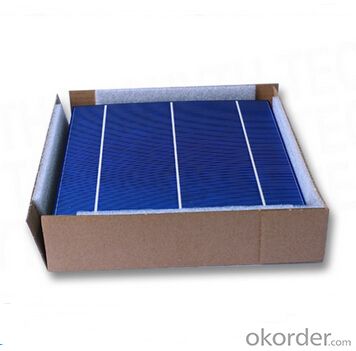
FAQ
We have organized several common questions for our clients,may help you sincerely:
①What price for each watt?
It depends on the efficiency of the solar cell, quantity, delivery date and payment terms.
②How long can we receive the product after purchase?
In the purchase of product within three working days, We will arrange the factory delivery as soon as possible. The pecific time of receiving is related to the state and position of customers.Commonly 7 to 10 working days can be served.
③Can you provide the peripheral products of the solar panels, such as the battery, controller, and inverter? If so, can you tell me how do they match each other?
Yes, we can, we have two companies for solar region, one is CNBM International, the other is CNBM engineering Co.
We can provide you not only the solar module but also the off grid solar system, we can also provide you service with on grid plant.
④What is your warranty of solar cell?
Our product can promise lower than 0.3% open box crack, we support claim after opening the box if it has crackm color difference or sth, the buyer should give pictures immediately, we can not accept the claim after the solar cell has assembled to solar panel.
• Timeliness of delivery
• ⑤How do you pack your products?
We have rich experience on how to pack the solar cell to make sure the safety on shipment, we could use wooden box or pallet as buyer's preference.
- Q: How long is the long cycle solar cell life?
- There are discharge depth, such as each time the actual capacity of the battery only 30% of the battery, you can cycle more than 1500 times, that is, 4 years or so, but if every 80%, then only more than a year, 100% It is about 1 year it
- Q: Can solar cells be used to power water purification systems?
- Yes, solar cells can be used to power water purification systems. Solar-powered water purification systems use the energy from the sun to generate electricity, which is then used to power pumps, filters, and other components of the water purification process. This sustainable and renewable energy source makes solar cells an effective and environmentally friendly solution for powering water purification systems, especially in areas with limited access to electricity grids.
- Q: Where can I get a competitive price for this solar cell? The 2bb/3bb polycrystalline solar cell panel?
- 2bb/3bb polycrystalline solar cell panel is a conventional solar cell you can basically get anywhere, but mostly it is produced in China.
- Q: How about the solar cell 156mm Mono-Crystalline?
- It is difficult to explain, but the measurement usually doesn't matter, because only the materials matters most for the solar cells.
- Q: What is the pollution of solar cells?
- the city warehouse classification storage; 5, centralized custody, waiting for the introduction of domestic waste battery recycling technology; 6, increase the size of the battery recycling; 2, regular hand-site acquisition; 3, battery classification (ordinary battery, button batteries)
- Q: How can solar cells be used in residential applications?
- Solar cells can be used in residential applications by installing solar panels on rooftops or other open areas to capture sunlight and convert it into electricity. This clean and renewable energy source can power various appliances and lighting systems within a home, reducing reliance on traditional grid electricity and lowering utility bills. Additionally, excess energy generated by solar cells can be stored in batteries or fed back into the grid, further promoting sustainability and potentially earning homeowners credits or incentives.
- Q: Anybody ever heard of solar roll flexible solar panel?
- It could be a portable solar panel charges your digital camera, camcorder, GPS, and satellite phone. Expedition members no longer need to pack heavy batteries for their worldwide journeys.
- Q: Can solar cells be used to power data centers?
- Yes, solar cells can be used to power data centers. With advancements in solar technology, solar panels can generate enough electricity to meet the energy demands of data centers. Additionally, data centers can integrate battery storage systems to ensure uninterrupted power supply during periods of low sunlight.
- Q: Are solar cells affected by shade?
- Yes, solar cells are affected by shade. When solar cells are partially shaded, it reduces their efficiency and overall power output. Shading can create hotspots on the shaded cells, causing them to generate less electricity and potentially damage the cells. Therefore, it is important to ensure that solar panels are installed in areas with minimal shade to maximize their performance.
- Q: What is the impact of snowmelt on solar cell efficiency?
- The impact of snowmelt on solar cell efficiency is generally positive. When snow covers solar panels, it reduces their ability to generate electricity due to the lack of sunlight reaching the cells. However, as the snow melts and slides off the panels, it allows for maximum exposure to sunlight, thus improving the efficiency and energy production of the solar cells.
Send your message to us
Agbis2 Polycrystalline Solar Cells Series- 16.0-17.2
- Loading Port:
- Shanghai
- Payment Terms:
- TT OR LC
- Min Order Qty:
- 3000 pc
- Supply Capability:
- 300000 pc/month
OKorder Service Pledge
OKorder Financial Service
Similar products
Hot products
Hot Searches
Related keywords
